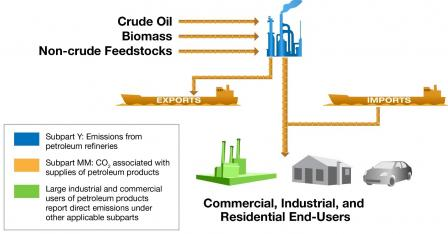GHGRP 2021: Suppliers of Petroleum Products
•Emissions Trends •Emissions by GHG •Emissions by Location •Emissions Ranges
Sector Data Highlights
•Chemicals (Non-Fluorinated Chemicals) (Fluorinated Chemicals) •Electrical Equipment •Electronics Manufacturing •Metals •Minerals •Miscellaneous Combustion •Petroleum and Natural Gas Systems (Onshore Production) (Other Industry Segments) •Power Plants •Pulp & Paper •Refineries •Underground Coal Mines •Waste •Suppliers •Natural Gas and Natural Gas Liquids •Petroleum Products •Industrial GHGs & Products Containing GHGs •Supply, Underground Injection, and Geologic Sequestration of CO2 •Fluorinated GHG Emissions and Supplies
![]() This sector comprises petroleum refineries and importers and exports of petroleum products and natural gas liquids. These suppliers do not report direct emissions, but instead report the quantity of CO2 that would be emitted if the fuels and other products they supply each year were combusted. Petroleum refineries also report the volume of all feedstocks entering the refinery.
This sector comprises petroleum refineries and importers and exports of petroleum products and natural gas liquids. These suppliers do not report direct emissions, but instead report the quantity of CO2 that would be emitted if the fuels and other products they supply each year were combusted. Petroleum refineries also report the volume of all feedstocks entering the refinery.
Emissions associated with these products do not occur at the supplier's facility but instead occur throughout the country, wherever they are used. The full GHG quantity reported by suppliers might not always result in GHG emissions, and the emissions might not take place during that particular reporting year. An example is ethylene, which is a byproduct from petroleum refining that is often used to produce plastics.
The GHG quantities reported by suppliers can be accessed through the suppliers section of FLIGHT. Petroleum refineries also report direct emissions under other applicable subparts. Click here to learn more.
- Graphic of the petroleum product supply chain
- Trend of Annual Reported CO2 Quantity Associated with Refinery Petroleum Products Produced (as of 8/12/2022)
- Number of reporters and emissions associated with refinery petroleum products produced
Graphic of the petroleum product supply chain

Trend of Annual Reported CO2 Quantity Associated with Refinery Petroleum Products Produced (as of 8/12/2022)
What factors influenced the trends in emissions for suppliers of petroleum products?
Number of reporters and emissions associated with refinery petroleum products produced
| Petroleum Product Suppliers Sector - Number of Reporters | ||||||||||
|---|---|---|---|---|---|---|---|---|---|---|
| 2012 | 2013 | 2014 | 2015 | 2016 | 2017 | 2018 | 2019 | 2020 | 2021 | |
| Importers | 86 | 87 | 90 | 92 | 89 | 91 | 84 | 84 | 84 | 83 |
| Exporters | 60 | 61 | 64 | 64 | 69 | 72 | 68 | 63 | 65 | 64 |
| Petroleum Refineries | 137 | 136 | 136 | 137 | 136 | 137 | 135 | 136 | 136 | 132 |
| Petroleum Refineries – CO2 Quantity Associated with Supplied Productsa (million metric tons CO2) |
||||||||||
|---|---|---|---|---|---|---|---|---|---|---|
| 2012 | 2013 | 2014 | 2015 | 2016 | 2017 | 2018 | 2019 | 2020 | 2021 | |
| Petroleum Refineries | 2,150.7 | 2,320.2 | 2,393.3 | 2,443.8 | 2,474.0 | 2,514.8 | 2,574.9 | 2,514.9 | 2,216.6 | 2,309.7 |
a Carbon dioxide quantities shown in this table exclude petroleum refineries whose carbon dioxide quantities are considered confidential business information

